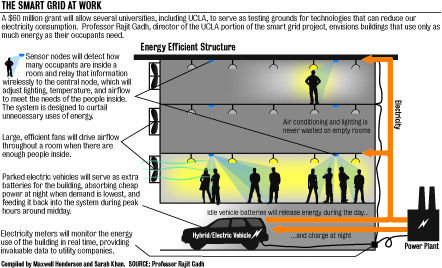Smart grid technology saves money, energy by using sensors in buildings, battery power from electric cars

By Sarah Khan
Feb. 11, 2010 9:59 p.m.
The electric power transmission grid of Los Angeles is about to get an upgrade, in part because of research at UCLA looking at new smart grid technology that may save money for consumers.
Smart grid technology allows real-time data about the energy needs of individual buildings and homes to be collected, said Michael Swords, executive director of Strategic Research Initiatives within the Office of the Vice Chancellor for Research.
When the price of energy goes up, the utilities will instead be able to use energy stored in an electric car’s battery in order to save money for the consumer, Swords added.
UCLA is collaborating with the University of Southern California and the California Institute of Technology on this smart grid technology research project, using a five-year $60 million grant that was awarded by the Los Angeles Department of Water and Power in December.
Cutting costs is just one benefit of smart grid technology. Because energy utilities can adjust in real time to the energy needs of the customers, individuals who are concerned about the environment will be able to cut their excess energy use through the smart grid network, said Rajit Gadh, leader of the smart grid demonstration project and professor of mechanical and aerospace engineering.
Smart grid technology will involve storing energy in the batteries of electric vehicles when prices go up, Swords said. With this smart grid research project, researchers are looking at ways to integrate such a storage capacity into the grid, Swords said.
During the summer months, for example, consumers use more energy to air condition their homes in the afternoon, Gadh said. During these times, the price of energy increases, he added.
Utilities would be able to use the stored energy in an electric vehicle’s battery and give the owner of the vehicle a price discount, he said.
These vehicles may become more popular in the future as they become more available to consumers, and the energy grid will need to be adjusted to accommodate them, Swords said.
Devices called smart meters would act as the communication link between the utility and the consumer’s vehicle. The consumer could get a discount on energy every time the utility uses the vehicle’s stored energy, Gadh said.
In order to implement this technology, researchers have been looking into how people differ in their use of energy. This research, called demand-response research, uses monitors and sensors to collect data in real time about the specific ways that energy is used, Gadh said.
At UCLA, for example, a humanities building uses energy differently than a mechanical engineering building, Gadh said.
Experimenting with demand response on campus will eventually lead to the integration of these new technologies in UCLA buildings, he said. In a few years, UCLA will serve as a “micro grid” to test and demonstrate the ongoing research, he added.
The research grant itself is for five years of designing and implementing the smart grid technology on campus.
Researchers are looking to experiment on buildings at UCLA such as offices, parking lots and residential buildings. These testing grounds could help solve problems that would arise when outfitting the technology to other buildings in Los Angeles, Gadh said.
Gadh is looking to involve UCLA students from disciplines outside of engineering, according to a statement released by UCLA in January. He plans to use students from other disciplines to look at the smart grid technology from different perspectives and to answer questions, including some about the economic and political impacts of this research project, according to the statement.
The technology is expected to be implemented in the Los Angeles area and eventually throughout the state through public and privately owned utilities, Swords said. The technology may also be commercialized and used throughout the country and the world, he added.
“This smart grid demonstration project is the ultimate example of how technology can be developed at the universities and commercialized and marketed to the world,” Swords said.
Through smart grid demonstration research, students at UCLA have the chance to become more educated about how money is spent on energy. They can make informed decisions about how to spend their own money in the future, Gadh said.
“(Students) will be living in apartments, homes, buildings and going to work in offices. They will see this research and understand what smart grid means and what the potential benefits are to themselves as consumers,” Gadh said.
Smart grid research gives UCLA and other institutions a chance to change and upgrade the infrastructure of the country, he added.
“This is an amazing opportunity to change and actually define where the … grid of the future is going,” Gadh said.

